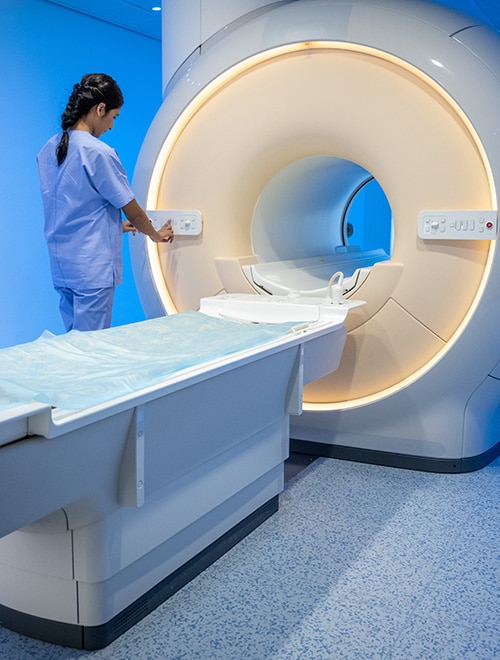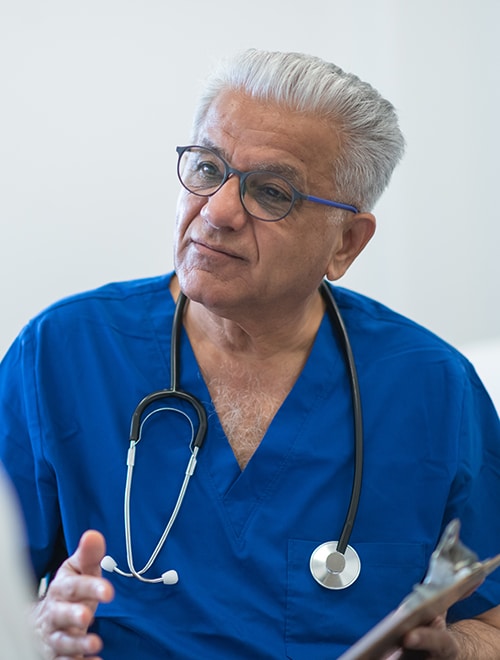- 7 min read
What is active surveillance?
Active surveillance is a treatment option recommended for some localised prostate cancers instead of active treatments like radiation therapy or surgery. It involves regular monitoring and testing for any signs or symptoms that signal your prostate cancer is growing or spreading.
Most low-risk prostate cancers never progress and will never need treatment. But if your cancer starts to grow you will be offered active treatment.
Prostate cancer is generally slow-growing, and while most low-risk cancers don’t progress and become harmful, it is crucial that your cancer is regularly monitored for changes.
The aim of active surveillance is to detect changes to your cancer that suggest it is progressing and may need active treatment to prevent it spreading. A benefit of active surveillance is that you can delay, and possibly avoid, active treatment which comes with a lot of challenging side effects.
This section of your toolkit will help you and the significant people in your life, such as your partner, family and friends, understand what’s involved in active surveillance.
Who can have active surveillance?
Your doctor may recommend active surveillance if your prostate cancer is considered lower risk. This means the cancer remains inside your prostate (has not spread) and has a low risk of spreading or causing you problems or symptoms in the future.
Your cancer will be classed as low risk if you have the following test results:
- PSA levels less than and or equal to 10 ng/mL (10 µg/L)
- Low-grade cancer – this is when your ISUP Grade group is 1 or your Gleason score is equal to or less than 3 + 3 = 6
- Localised (early stage) cancer that is tumour stage TI or T2
Your doctor may also recommend active surveillance if your cancer is intermediate risk (ISUP Grade 2 group or Gleason Grade 3+4=7), or while you are deciding on your next steps in treatment.
Follow these links to learn more: About the PSA Test, Your Gleason Score and ISUP Grade and the Stages of Prostate Cancer.
What tests and procedures might you have during active surveillance?
During active surveillance your healthcare team will closely monitor you for any signs that your cancer may be progressing.
Active surveillance monitoring protocols can differ from person to person. Your doctor will consider your earlier test results, your risk factors, and your unique circumstances to design a plan that is best for you.
Your active surveillance monitoring protocol may include one or more of the following tests and/or procedures, done on a regular basis:
- PSA testing
- Digital rectal examinations (DRE)
- Imaging tests, such as MRI
- Biopsy
- Genomic or biomarker testing
Your healthcare team will look for any:
- Significant rises in your PSA level
- Increases in the grade (likelihood of progression) of your cancer
- Increases in the size of your cancer
Active surveillance is continuing to be reviewed and researched. As new evidence emerges and new tests and processes are developed, your urologist might recommend changes to your monitoring program. Talk to your doctor or reach out to a PCFA nurse for advice.
Deciding whether to go on active surveillance
It is important to be fully aware of what’s involved in active surveillance so you can make the best decision for you. Ask your urologist to explain what’s involved, the benefits, the risks and why they think it’s a good option for you. We have also listed information below to help you decide.
Is active surveillance safe?
The number of men with low-risk prostate cancer managed by Active Surveillance increased from 69% in 2015 to 80% in 2019.
There is strong evidence that it’s safe to be regularly and carefully monitored, without active treatment, if you have low-risk prostate cancer. Active surveillance may mean you avoid ever needing active treatment or it might delay your need for several years.
What are the benefits of active surveillance?
Some of the benefits for using active surveillance as a treatment option are:
- Your cancer is closely monitored for changes
- Side effects associated with active treatment, such as surgery or radiation therapy, are delayed or avoided
- You may never need active treatment if your prostate cancer monitoring suggests the cancer isn’t growing or spreading
Are there any side effects or other considerations with active surveillance?
- Your active surveillance plan may include regular digital rectal examinations or biopsies, both of which are more invasive procedures
- If you have a biopsy there’s a chance you may bleed and/or have pain or bruising afterward. There is also a small risk of infection. However, most biopsy side effects are manageable and short-term – you can find out more in the biopsy section of this toolkit
- With active surveillance you may have the same chance of living for 10 years as someone who chose to have surgery or radiation therapy, but active surveillance isn’t perfect and there is a risk that your cancer may progress without you or your doctor knowing.
If you’re still worried about choosing active surveillance or about not having active treatment, talk to your doctor, a PCFA nurse and/or prostate cancer support group members.
Why might you move from active surveillance to treatment?
The length of time you stay on active surveillance varies, depending on your individual circumstances.
Reasons you may move to active treatment include:
Changes in test results while on active surveillance
Your doctor may recommend changing to active treatment if your test results show the following:
- Increase in cancer grade – your biopsy results show that the cancer grade has increased suggesting the cancer may be progressing
- Increase in cancer size/growth – your PSA levels rise and / or your imaging test (MRI) and/or biopsy results show change in the cancer
Your doctor will review these results and discuss with you whether active treatment should be started.
Moving to active treatment for personal reasons
If you are on active surveillance and are uncomfortable or anxious about not having active treatment, it is important to talk to your doctor or a PCFA nurse and understand as much as you can about prostate cancer and the different treatment options available to you. Make sure you know about the different side-effects of active treatment and how they are managed. You can also contact our Prostate Cancer Counselling Service to talk to a PCFA nurse counsellor or psychologist.
Can you get a second opinion?
Of course! It’s very important that you are comfortable with your decision to stay on active surveillance or move to active treatment. Getting a second opinion doesn’t mean you have less faith in your doctor. Talking it through with another doctor or health professional who understands prostate cancer can help clear up some of your concerns and may deepen your understanding of the different treatment and support options for you.
If you need more information, you can contact a PCFA nurse. It can also be very helpful to discuss treatment options with your partner or a family member and take them along to your appointments.
How do you keep track of your appointments and test results during active surveillance?
It’s vital that you keep up with routine monitoring of your prostate cancer. Make sure you follow your monitoring protocol carefully and go to your appointments and have your tests at the times recommended by your doctor. Without regular monitoring, changes in your prostate cancer might be missed and the cancer could progress without you or your doctor knowing.
You can download a copy of My Wellbeing Plan to keep track of your appointments, test results and ongoing care information.
Keeping track of your tests and results can be overwhelming. To help you keep your diagnosis, appointment dates, test results, treatment and ongoing care information in one convenient place we designed the My Wellbeing Plan for you.
You can also take this to your appointments so that you and your healthcare team will have a clear understanding of your diagnosis and treatment plan.
Download a copy of the My Wellbeing Plan and ask a member of your healthcare team to help you complete it and keep it up to date at each appointment.
If you have any questions or issues completing the My Wellbeing Plan, you can contact a PCFA nurse.
Looking after yourself during active surveillance
If you are feeling distressed call a PCFA nurse on 1800 22 00 99. If you need urgent emotional or mental health support call Lifeline on 13 11 44 or Beyond Blue on 1300 22 46 36.
If you have prostate cancer, it is normal to have a wide range of feelings, emotions and you may even experience physical effects like feeling irritable or on edge. This is understandable, especially when you are awaiting test results.
It is important to look after your mental and physical wellbeing during active surveillance. You can read about ways to look after yourself in the Heath & Wellbeing section of this toolkit. If you would like more support talk to your doctor or get in contact with your GP or a PCFA nurse, who can also connect you with support groups, other health professionals and resources for you and your family and friends.
Watchful waiting versus active surveillance
Watchful waiting is sometimes used for prostate cancer management Watchful waiting is a process of monitoring for any symptoms from the cancer and treating these symptoms as they arise, but not aiming to ‘cure’ the cancer. It involves fewer tests than active surveillance.
Watchful waiting may be recommended if you have advanced prostate cancer and you are not able to have active treatments due to other health concerns and/or you have a shorter life expectancy.
If you are on watchful waiting and your cancer progresses you may be treated with hormone therapy. Hormone therapy may control growth of your prostate cancer for several years but isn’t aimed at curing your disease, like active treatment (such as surgery or radiation therapy). You may also be offered radiation therapy to treat ay symptoms you develop if your cancer has spread to other parts of your body.
Key points
- Active surveillance is a monitoring program to check if your prostate cancer is growing, mainly if you have a cancer considered low-risk.
- Active surveillance involves regular testing (blood tests, imaging scans and/or biospies) but does not include active treatment, such as radiation therapy or surgery, unless tests indicate that the cancer has progressed
- Your doctor will discuss an active surveillance plan with you, which is likley to involve multiple regular tests and procedures to monitor the cancer for any changes
- There is strong evidence that active surveillance is safe in certain circumstances and may delay or reduce the need for active treatment, such as surgery or radiation therapy
- Active treatment may be given if your test results show the cancer is progressing, or if it is your personal preference to have surgery or radiation therapy
- You can keep track of your active surveillance appointments and test results in the downloadable My Wellbeing Plan document
- It is important to seek support and look after your mental and physical health and wellbeing during active surveillance and help is available through PCFA






